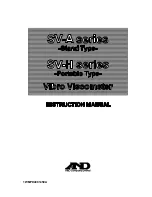
Manual No. OM5000
Jan X/04 Ver 1.40
5
TABLE I
Characteristic Ultrasonic Velocities for Some Selected
Common Materials (At Room Temperature,
Unless Otherwise Noted)
MATERIAL
ACRYLIC RESIN
AIR (20
E
C)
ALUMINUM
BRASS, NAVAL
BRONZE,PHOSPHO
R
CAST IRON
COPPER
GLASS, WINDOW
GLYCERINE
HYDROGEN (0
E
C)
INCONEL
IRON
MAGNESIUM
MONEL
MOTOR OIL
NICKEL
STEEL, MILD
STEEL, 4340
STEEL, 303 CRES
TITANIUM
WATER (20
E
C)
ZIRCONIUM
VELOCITY - in/us
0.105
*
0.014
0.249
0.174
*
0.139
*
0.181
*
0.183
*
0.267
*
0.076
0.050
0.225
*
0.232
0.248
0.237
0.069
0.222
0.232
0.230
0.223
0.239
0.058
0.183
VELOCITY - mm/us
2.67
*
0.34
6.32
4.43
*
3.53
*
4.60
*
4.66
*
6.79
*
1.92
1.28
5.72
*
5.90
6.31
6.02
1.74
5.63
5.90
5.85
5.66
6.07
1.48
4.65
* may exhibit wide velocity variations depending upon alloy or type
NOTE:
These reported ultrasonic velocities are only approximations because of
effects due to chemical and physical variations.
4.1.2 Thickness Gaging Concept
- The NovaScope operates on a pulse-echo principle quite
similar to that used for ranging with both sonar and radar. With regard to the NovaScope, a very
short pulse (burst) of megahertz-frequency ultrasonic energy is introduced into the material to be
gaged for thickness. The pulse travels through the material and reflects back an echo from the
opposite parallel surface of the material. The period of time for this pulse-echo round trip to occur
is related to the material thickness and the characteristic ultrasonic velocity for that material
according to the simple ratio relationship:












































